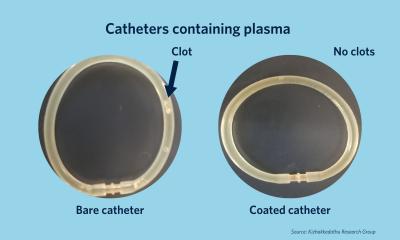Revolutionary Coating Developed to Combat Clot Formation in Medical Devices
In a groundbreaking advancement, researchers have developed a novel coating for blood-contacting devices that mimics the function of natural blood vessels, significantly reducing the risk of thrombosis, or clot formation, without relying on anticoagulants. This innovative approach has the potential to transform device design, promising improved patient safety and comfort.
Understanding Thrombosis and Its Risks
Thrombosis is a significant complication associated with medical devices that come into contact with blood, such as vascular catheters and dialysis machines. Unlike natural blood vessels, these devices often inadvertently trigger clotting by activating specific proteins in the bloodstream. This can lead to dangerous obstructions, severely disrupting treatment and raising the risk of life-threatening conditions such as stroke and heart attack.
Current medical practices often resort to administering high doses of blood thinners to mitigate clotting risk. However, this approach carries its own set of hazards, notably an increased likelihood of dangerous bleeding, which poses a significant concern for both patients and healthcare providers.
A New Paradigm in Device Coating
The newly developed coating offers a promising alternative to traditional methods. Engineered to closely imitate the functionality of blood vessels, the coating promotes normal blood flow while effectively preventing clot formation. Dr. Haifeng Ji, a postdoctoral fellow at the Center for Blood Research and the first author of the study, explains, “By interacting with a key blood protein in a controlled way, the coating prevents it from triggering a cascade of events that lead to clot formation.” This interaction can be visualized as a "soft barrier" on the device’s surface, attracting critical proteins while inhibiting their harmful activation.
In laboratory and animal studies, this innovative coating has demonstrated significant reductions in clot formation on device surfaces without the need for blood thinners, preserving the natural clotting mechanisms elsewhere in the body. Dr. Jayachandran Kizhakkedathu, a leading researcher in the study, remarked, “This shows us that mimicking the body’s own mechanisms, rather than simply repelling blood components, is key to truly biocompatible device design.”
Rising Demand for Blood-Contacting Devices
The impetus for this research is underscored by the skyrocketing demand for blood-contacting devices worldwide. In the United States alone, millions of vascular catheters are utilized each year, with hundreds of thousands of patients reliant on devices like dialysis machines for their survival and health management.
Implications for the Future
As researchers delve deeper into the biological mechanisms that underlie the effectiveness of this coating, the potential applications for medical devices could substantially expand. The development signals the dawn of a new generation of innovative technologies designed not only to prevent clotting but also to integrate seamlessly with the body’s natural processes.
Healthcare professionals and patients alike stand to benefit from these advances, which aim to improve the safety and efficiency of medical treatments involving blood-contacting devices. The future of biocompatible devices could very well hinge on these revolutionary findings, paving the way for safer medical interventions.
Join the Conversation
How do you think advancements in medical device technology will impact patient care in the years to come? Share your thoughts in the comments below, and don’t forget to explore related articles on Shorty-News about cutting-edge innovations in healthcare technology.
For more insights into the evolving landscape of medical technology, consider reading TechCrunch or Wired.

